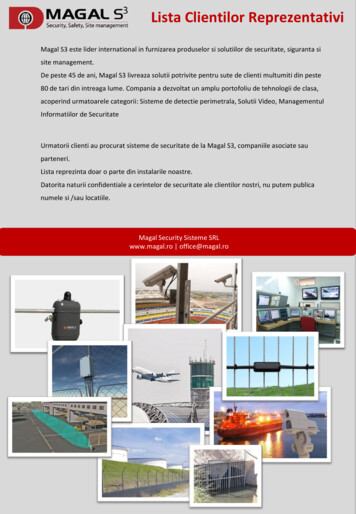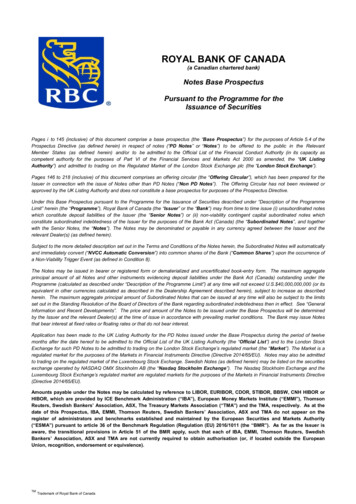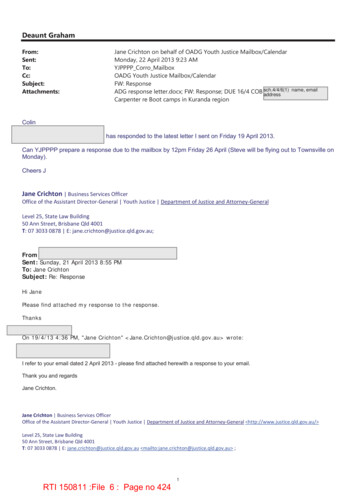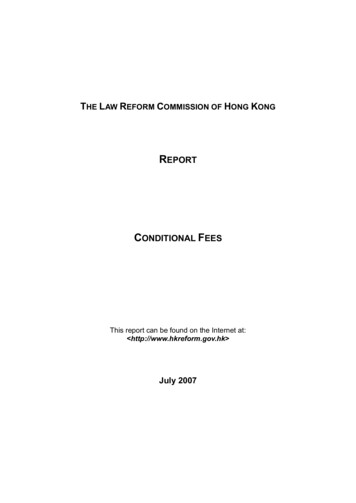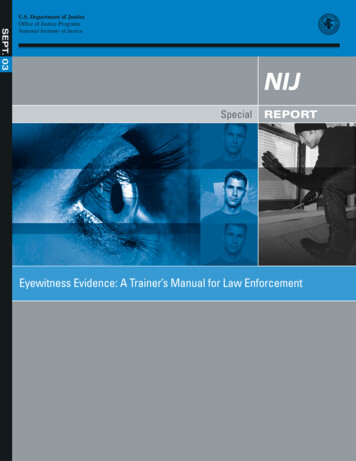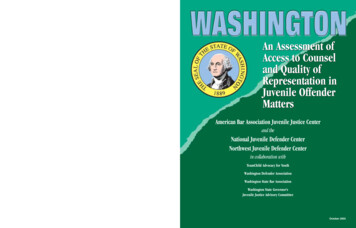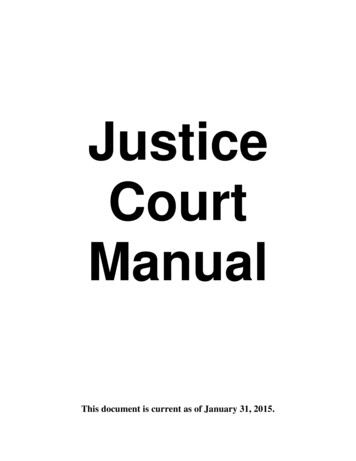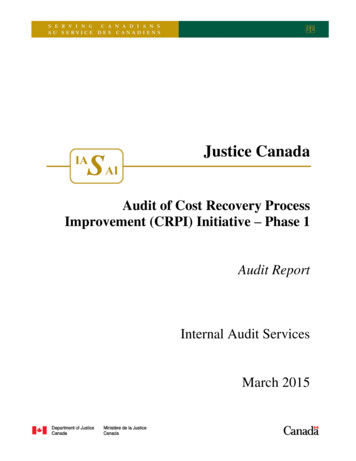
Transcription
S AIIAJustice CanadaAudit of Cost Recovery ProcessImprovement (CRPI) Initiative – Phase 1Audit ReportInternal Audit ServicesMarch 2015
Information contained in this publication or product may be reproduced, in part or inwhole, and by any means, for personal or public non-commercial purposes, withoutcharge or further permission, unless otherwise specified.You are asked to:exercise due diligence in ensuring the accuracy of the materialsreproduced;indicate both the complete title of the materials reproduced, as well as theauthor organization; andindicate that the reproduction is a copy of an official work that is published bythe Government of Canada and that the reproduction has not been produced inaffiliation with or with the endorsement of the Government of Canada.Commercial reproduction and distribution is prohibited except with writtenpermission from the Department of Justice Canada. For more information, pleasecontact the Department of Justice Canada at: www.justice.gc.ca. Her Majesty the Queen in Right of Canada,represented by the Minister of Justice and Attorney General of Canada, 2015ISBN 978-0-660-02038-9Cat. No J22-27/2015E-PDF
Department of Justice CanadaTable of Contents1.Executive Summary. 32.Background . 53.Audit Objective. 64.Audit Scope . 65.Audit Approach . 66.Findings, Recommendations and Management Action Plan . 66.1 Governance . 86.1.1 Finding 1: Roles and Responsibilities . 96.1.2 Finding 2: Reporting and Monitoring . 106.1.3 Finding 3: Oversight . 136.1.4 Finding 4: Client Satisfaction . 147.Audit Opinion . 168.Statement of Conformance . 16Appendix A – Audit Criteria. 18Internal Audit ServicesC.5.1Page 2 of 18
Department of Justice Canada1. Executive SummaryJustice Canada provides litigation and legal advisory services to federal governmentdepartments, agencies and Crown Corporations across Canada. The Department uses a hybridmodel to fund its operations, relying on a mix of A-base funding to provide a certain level oflegal services, and Net Voting Authority (NVA) to recover the costs of legal services from clientorganizations over and above this base level. NVA (cost recovery) is an important source offunding for the Department, providing more than a third of the operating budget. The TreasuryBoard (TB) Common Services Policy sets out a strategic direction and outlines key requirementswith respect to cost recovery.The Cost Recovery Process Improvement (CRPI) Initiative commenced in August 2010 toexamine and re-engineer Justice’s end-to-end cost recovery processes and reporting, and in sodoing respond to deficiencies noted in the 2010 Internal Audit of the Cost Recovery Framework.The objectives of the CRPI Initiative included improving business processes and enhancingcorporate systems with a view to reducing administrative effort, supporting timely cashcollection, meeting central agency policies and directives as well as better leveraging establishedGovernment of Canada best practices to track and invoice professional services.The changes flowing from the CRPI Initiative were implemented on April 1, 2012. To supportthe implementation, CRPI guidance was developed, roles and responsibilities were documentedand communicated, and staff from across the Department received training. There is costrecovery reporting and monitoring at the individual client level, namely within Legal ServicesUnits (LSUs) and portfolios. While there is some strategic cost recovery reporting and oversightvia the Financial Situation Reporting and year-end financial reporting processes, the frequencyand nature of in-year cost reporting does not support senior management in actively monitoringcost recovery and taking corrective action on a timely basis as may be required.Soliciting feedback from clients following the implementation of major changes to the costrecovery system is critical to ensuring that clients’ needs have been sufficiently considered andaddressed. This is particularly the case in regards to Justice’s invoicing processes for legalservices. While ad hoc feedback is sometimes received by LSUs in this regard, there is nomechanism in place to systematically solicit and capture information on client satisfaction withrespect to CRPI.The Department has recently embarked on a review of its legal services funding model. Whilethis may lead to changes in the model by which the Department recovers legal service costs fromclients, the importance of sound governance processes and practices, recommendations for whichare addressed as part of this report, will remain.Management ResponseManagement is in agreement with the audit findings, has accepted the recommendations includedin this report, and has developed a management action plan to address them. The managementaction plan has been integrated in this report.Internal Audit ServicesC.5.1Page 3 of 18
Department of Justice CanadaSubmitted by:Linda SaundersChief Audit ExecutiveDepartment of Justice CanadaDateRecommended for approval by:Hon. Doug LewisDepartmental Audit Committee ChairDepartment of Justice CanadaDateApproved by:William F. PentneyDeputy MinisterDepartment of Justice CanadaInternal Audit ServicesC.5.1DatePage 4 of 18
Department of Justice Canada2. BackgroundJustice Canada provides litigation and legal advisory services to federal governmentdepartments, agencies and Crown Corporations across Canada. The Department uses a hybridmodel to fund its operations, relying on a mix of A-base funding to provide a certain level oflegal services, and Net Voting Authority (NVA) to recover the costs of legal services from clientorganizations over and above this base level. NVA (cost recovery) is an important source offunding for the Department, providing more than a third of the operating budget. The TreasuryBoard (TB) Common Services Policy sets out a strategic direction and outlines key requirementswith respect to cost recovery.The Cost Recovery Process Improvement (CRPI) Initiative commenced in August 2010 toexamine and re-engineer Justice’s end-to-end cost recovery processes and reporting, and in sodoing respond to deficiencies contained in the 2010 Internal Audit of the Cost RecoveryFramework. The objectives of the CRPI Initiative included improving business processes andenhancing corporate systems with a view to reducing administrative effort, supporting timelycash collection, meeting central agency policies and directives as well as better leveragingestablished Government of Canada best practices to track and invoice professional services.In support of these objectives, eleven new standards were put in place effective April 1, 2012 tostandardize the five business processes that collectively make up the CRPI Initiative, namely:1. Memorandums of Understanding (MOUs), including Annex Bs that support planning andforecasting;2. Timekeeping;3. Reimbursable Disbursements;4. Invoicing; and5. Accounts Receivable Settlements.In 2013-2014, the Department recovered legal service costs of 330.2M as well as 8.6M (2%)of reimbursable disbursements.In accordance with the Departmental Risk-based Audit Plan 2014-2017 which was approved bythe Deputy Minister on June 5, 2014, Internal Audit Services undertook an audit of the CostRecovery Process Improvement (CRPI) Initiative. Given the complexity, risks and magnitude ofthe cost recovery system, this audit was split into two phases. This report represents the resultsof Phase 1 of the audit which is focused on Governance. Audit results associated with Phase 2are scheduled for tabling at the September 2015 Departmental Audit Committee (DAC) meeting.The latter phase focuses on efforts undertaken by management to streamline and standardize costrecovery business processes.Internal Audit ServicesC.5.1Page 5 of 18
Department of Justice Canada3. Audit ObjectiveThe objective of this audit was to provide assurance that effective mechanisms are in place tosupport continued delivery of the Cost Recovery Process Improvement (CRPI) Initiativeoutcomes. In relation to this, Phase 1 of the audit examined CRPI Governance; Phase 2 of theaudit will examine the effectiveness of management’s efforts to streamline and standardizeassociated business processes.4. Audit ScopeBased on the results of a risk assessment conducted during the planning phase, the scope ofPhase 1 of the audit focused on governance processes and practices with respect to cost recoveryfrom April 2013 to October 2014. Also included in the scope was an examination of processesand practices in place to solicit cost recovery feedback from legal services clients.5. Audit ApproachThe audit team carried out its mandate in accordance with Treasury Board’s Policy on InternalAudit and the Internal Auditing Standards for the Government of Canada. The audit employedvarious techniques including a risk assessment of the audit entity, interviews, file reviews, aswell as reviews and analysis of documentation and information.6. Findings, Recommendations and Management Action PlanThis section provides the findings and recommendations resulting from the audit work carriedout. While the audit was conducted based on the lines of enquiry and audit criteria identified inthe planning phase, this report is structured along the following main findings:1.2.3.4.Roles and Responsibilities;Reporting and Monitoring;Oversight; andClient Satisfaction.For conclusions by audit criterion, please refer to Appendix A.Based on the audit work performed and our professional judgment, the risk associated with eachfinding was rated using a three-point scale. The risk ranking (high, moderate, and low) is basedon the level of potential risk exposure we feel may have an impact on the achievement of JusticeCanada’s objectives, and is indicative of the priority Management should give to theInternal Audit ServicesC.5.1Page 6 of 18
Department of Justice Canadarecommendations associated with that finding. The following criteria were used in determiningthe risk exposure level:Controls are not in place or are inadequate.Compliance with legislation and regulations is inadequate.HighImportant issues are identified that could negatively impact the achievement ofprogram/operational objectives.Controls are in place but are not being sufficiently complied with.Compliance with central agency/departmental policies and established proceduresModerate is inadequate.Issues are identified that could negatively impact the efficiency and effectivenessof operations.Controls are in place but the level of compliance varies.Compliance with central agency/departmental policies and established proceduresvaries.LowIssues identified are less significant but opportunities that could enhanceoperations exist.Internal Audit ServicesC.5.1Page 7 of 18
Department of Justice Canada6.1 GovernanceCost recovery is an important source of funding for the Department, providing 330.2M in2013-2014, or approximately one-third of the operating budget. The Cost Recovery ProcessImprovement (CRPI) Initiative was initiated in August 2010 to examine and re-engineerJustice’s end-to-end cost recovery processes. The resulting changes to the process came intoeffect on April 1, 2012. The CRPI is comprised of five business processes as follows:1. Memorandums of Understanding (MOUs), including Annex Bs that support planningand forecasting;2. Timekeeping;3. Reimbursable Disbursements;4. Invoicing; and5. Accounts Receivable Settlements.Throughout the duration of the CRPI Initiative, active monitoring and oversight was providedby the CRPI Project Committee (January 2011 - July 2012). Following the implementation ofthis initiative, the CRPI Project Committee was disbanded. While responsibility for an initialsuite of system changes was delegated to a Change Advisory Board, lead responsibility forvarious elements of the cost recovery process was dispersed to the respective business ownersthroughout the organization.Given the magnitude of this initiative and the criticality of the revenues generated throughcost recovery, effective governance processes and practices are required to ensure theDepartment continues to achieve the expected results of the CRPI Initiative. As outlined inthe CRPI Project Charter, this initiative was designed to: Promote consistent business practices across the Department;Smooth out cash flows so they are received on a more predictable basis throughoutthe fiscal year;Address client Departmental expectations;Achieve greater policy compliance; andRespond to prior audit findings and recommendations.Internal Audit ServicesC.5.1Page 8 of 18
Department of Justice Canada6.1.1Finding 1: Roles and ResponsibilitiesLinkage to:GovernanceRisk ManagementControlLowCost recovery roles and responsibilities are documented and have beencommunicated across the Department. Interviews conducted withdepartmental staff indicated that cost recovery roles and responsibilitieswere clear and well understood.Roles and responsibilities for each of the five elements of the cost recoveryprocess are clearly documented in the CRPI Supplementary Documentation.This is a key document that is readily available on the Department’s intranetand was referenced in the suite of guidance used to train departmental staff onthe new CRPI. Cost recovery reporting and monitoring roles andresponsibilities are also documented in the CRPI SupplementaryDocumentation, with specific reference to in-year cost recovery reporting andmonitoring through the Financial Situation Reporting (FSR) process.The Department’s Accountability Framework for MOU Related to theProvision of Legal Services elaborates further on roles and responsibilities withrespect to the MOUs and Annex Bs development, negotiation and monitoringprocesses. The CRPI Project Close-Out Report clearly assigns to Managementand CFO Sector the responsibility for the support, maintenance andtroubleshooting of the financial system-related elements of cost recovery.Interviews with staff responsible for the various elements of the cost recoveryprocess indicated Departmental staff have a sound awareness and understandingof their roles and responsibilities. A number of interviewees indicated that theyfind the CRPI support provided by the Management and CFO Sector to betimely and very helpful.Internal Audit ServicesC.5.1Page 9 of 18
Department of Justice Canada6.1.2Finding 2: Reporting and MonitoringLinkage to:GovernanceRisk ManagementControlProcesses and practices are in place and operating effectively to supportcost recovery reporting and monitoring at the client level. However, thefrequency and nature of cost recovery reporting does not support activemonitoring and oversight at the strategic or corporate level.ModerateMOUs and Annex BsThe Treasury Board Common Services Policy requires departments providingmandatory common services to “develop, in consultation with clientdepartments and agencies, meaningful and visible standards of service andperformance for the delivery of mandatory services.” The Department ofJustice has an MOU Framework in place that provides the overarching structureand expectations with respect to the development, negotiation and approval ofclient agreements (i.e. umbrella MOUs often covering more than one year andaccompanying Annex Bs that are negotiated annually). This Frameworkincludes the expectation that “the status of MOU implementation will bemonitored and shared with senior management at least once a year.” ThisFramework also specifies that by April 1st each year, the financial codesnecessary for cost recovery (i.e. Interdepartmental Settlement codes) are to beobtained from clients and reflected in Annex B.At the client level, the Finance and Planning Branch of Management and CFOSector maintains an MOU repository. The Branch periodically produces anExcel spreadsheet that reflects the status of MOUs and Annex Bs by client andportfolio. Once the associated information is validated by related branches andportfolios, the spreadsheet is posted on the Department’s intranet site.At the Department level, the Business Practice and Intelligence Branch ofManagement and CFO Sector produced a high level status report for the 20122013 fiscal year. This reporting, tabled at Management Committee (MC) inSeptember 2013, reflected the status of MOUs and Annex Bs by portfolio.However, the reporting did not include any accompanying client information.While this reporting may have technically fulfilled the requirements of “annualMOU status reporting” as outlined in the MOU Framework, the nature of it wasat such a high level that it did not provide MC with meaningful insight toclearly link the absence of required Annex Bs to client billings, particularly inrelation to the Department’s top billers. In addition, the tabling of this 20122013 report after year end, with no corresponding in-year MC reporting, wasnot optimal to support senior management in the timely identification andmanagement of significant or systemic issues in this area.Internal Audit ServicesC.5.1Page 10 of 18
Department of Justice CanadaThere was no MOU status reporting for 2013-2014 or to date for 2014-2015. Inthe first quarter of 2014-2015, there was a 15% reduction in cost recoveryrevenue from approximately 36M at June 30, 2013 to approximately 30.6Mat June 30, 2014. This was primarily the result of the less than timely receipt ofsigned Annex Bs and the receipt of Interdepartmental Settlement (IS) codes thatfacilitate the timely collection of cost recovery revenue. This issue came tolight via the Department’s external Quarterly Financial Report. Regularizedstrategic reporting that clearly links cost recovery revenue with the statusreporting on Annex Bs and receipt of IS codes would provide timely, relevantinformation to support MC in their monitoring role.Interviews indicated that resource constraints resulted in the absence of anyMOU status reports being developed or communicated to MC since 2012-2013.The Business Practice and Intelligence Branch and CFO Sector have indicatedthat work is underway to strengthen MOU monitoring and oversight processesfor 2015-2016 including the tracking, escalation and status reporting toPortfolios, Branches and MC.RevenueAs previously stated, expectations for cost recovery monitoring and reporting,including in-year cost recovery reporting and monitoring through the FinancialSituation Reporting (FSR) process are outlined in CRPI SupplementaryDocumentation.Each month the Finance and Planning Branch (FPB) develops Cost RecoveryBilling Reports and posts them on the Department’s intranet. This reportingreflects actual cost recovery billings by portfolio and by client for the relatedmonth as well as total year-to-date billings. As noted in interviews, thisreporting supports LSUs in monitoring and discussing in-year billings withclients, reviewing and updating client forecasts, and planning for the next fiscalyear.On a quarterly basis, the FPB updates the consolidated revenue forecast for theDepartment and communicates this information to MC via the FinancialSituation Reporting (FSR) process. However, we noted that the nature of thecost recovery information reflected in these reports varied from quarter toquarter. For example, the updated revenue forecast reflected in the October2014 FSR included a one line adjustment that is based on a historical trendingof forecasting accuracy. For the corresponding quarter of the preceding year(i.e. October 2013), the revenue forecast reflected a brief summary by portfolioas well as client details for major reductions in forecasted revenue.In addition, the FPB prepares the monthly FSRs and the year-end update report.Monthly FSRs and year-end reporting for 2013-2014 provided an explicitcomparison of actual cost recovery revenue versus the forecast of the prior year.Internal Audit ServicesC.5.1Page 11 of 18
Department of Justice CanadaThe reporting included the identification of material differences between actualand forecasted cost recovery revenue for the period and the key clients whosedelayed billings were the main reason for the difference. The 2014-2015 FSRsinclude a similar bar chart comparison of actual cost recovery for the currentand prior year. However, there was no inclusion of a comparison againstforecast nor was there a clear identification of, or information on, the variancebetween the current and prior year’s actual cost recovery revenue, either for themonth or year-to-date.The absence of a clear comparison of actual cost recovery revenue againstforecast, particularly for the Department’s top 20-30 clients, makes it achallenge for MC to readily monitor the timeliness of cost recovery cash flowsand address any related issues that may arise.Recommendation 1Management Action PlanManagement and CFO Sector shouldreview and refine its in-year and year-endcost recovery reporting and monitoringinformation and processes to better supporteffective strategic monitoring and oversightof the cost recovery system.The Management and CFO Sector will updatethe “Accountability Framework forMemorandum of Understanding related to theProvision of Legal Services” and willimplement a process for monitoring andreporting starting in Fiscal Year 2015-16, whichwill address concerns with respect to thefrequency and the nature of the reporting toManagement Committee.The Management and CFO Sector will providethe Management Committee with a consolidatedcomparison of the actual cost recovery revenuesversus forecast revenue in the FinancialSituation Report (FSR) in greater details, aswell as obtain information suggested byManagement Committee starting with the June2015 FSR process.Office of Primary Interest: Management and CFO SectorDue Dates: July 31, 2015 - Obtaining ManagementCommittee members’ input and guidance on theinformation they need through the FSR process.March 31, 2016 - Remainder of the MAPInternal Audit ServicesC.5.1Page 12 of 18
Department of Justice Canada6.1.3Finding 3: OversightLinkage to:GovernanceRisk ManagementControlThere is effective oversight of some elements of the cost recovery system.Opportunities exist to refine the oversight of cost recovery to support thecontinued achievement of the expected outcomes that the system was designed todeliver on.The design and implementation of the CRPI Initiative included mechanisms tosupport oversight. This included a CRPI Project Committee, co-chaired by twoDepartmental executives, which oversaw the design and implementation of thisinitiative and a Change Advisory Board responsible for overseeing an initial suite ofchanges to the cost recovery system.Following the implementation of the CRPI Initiative, it was expected that strategicoversight for cost recovery, a regime that generates revenue to cover approximatelyone-third of the Department’s budget, would shift to an existing Departmentalcommittee. Management Committee (MC) is the Department’s decision-makingforum. As outlined in its Terms of Reference, the committee is responsible for “legalservice delivery, horizontal management, operational and accountability issuesaffecting the Department.” Given the horizontal nature of CRPI and the criticality ofcost recovery revenue to funding the Department’s operations, MC plays a key role inthe strategic oversight of cost recovery.To support the Management Committee in its overall role, we noted that betweenApril 2013 and October 2014, members of this Committee received and reviewed thefollowing cost recovery reporting: Financial Situation Reports (FSRs) are tabled at MC throughout the year and aYear-End Financial Update is tabled once at MC a few months following yearend; Annual Cost Recovery Analysis report for the two fiscal years that providedan analysis of total cost recovery revenues (NVA) and the associated costs,both in dollar and percentage terms for the Department as a whole; and A high level MOU and Annex B status report for the 2012-2013 fiscal yearentitled Report to Management Committee on MOU Completion Status for2012-13.The above reports provide some information on cost recovery. However, the natureand frequency of the reporting does not readily support senior management ineffectively exercising its oversight role in this area. For example, with little to noreporting to MC on the status of MOUs and Annex Bs, MC may not be able toidentify or address significant and/or systemic issues on a timely basis.Internal Audit ServicesC.5.1Page 13 of 18
Department of Justice CanadaWhile the Department is reviewing and considering changes to the funding model,effective oversight will continue to be imperative to ensure the efficient managementof an area that is highly decentralized and material to Departmental operations.Recommendation 2Management Action PlanManagement Committee should review andrefine the nature and frequency ofManagement Committee’s review anddiscussion of critical elements of the costrecovery system to ensure continuedachievement of the benefits derived from theinvestment in the Cost Recovery ProcessImprovement Initiative.The Management Committee will beprovided with an opportunity to discussreporting requirements on CRPI as part of theJune 2015 FSR process. At a minimum,Management Committee will be providedwith the new information outlined in themanagement action plan for recommendation#1.Office of Primary Interest: Management CommitteeDue Date: March 31, 20166.1.4Finding 4: ClientSatisfaction6.1Subsection title / theme 2GovernanceRiskManagementControlto: GeneralLinkagecontext informationabout the topic goesherealong with audit criteriacontext. Ad hoc client feedback is sometimes received by LSUs. However, no formal orsystematic mechanism is in place to solicit and capture client satisfaction6.2 toSubsectiontitle / theme 2information with respectCRPI.ModerateSince2006,informationthe Departmenta surveyeveryto solicit Generalcontextabouthastheundertakentopic goes herealongwiththreeaudityearscriteriacontext. feedback from clients. The primary focus of this survey is to gain insight into thequality, accessibility, responsiveness, usefulness and timeliness of legal servicesprovided. To date, the survey has not encompassed cost recovery, including clientinvoicing and administrative burden.The integration of LSUs in major client departments provides for a close workingrelationship between Justice lawyers and the client. This working relationship canprovide an informal mechanism for clients to provide feedback on the cost recoverysystem, including the changes flowing from CRPI.The implementation of the Billing Manager Review process and the Final QualityAssurance (QA) Review and Approval process supports improved accuracy of clientinvoices. Interviews with those involved in this process pointed to a reduction in theInternal Audit ServicesC.5.1Page 14 of 18
Department of Justice Canadanumber of questions and concerns expressed by clients following the issuance of aninvoice in a post-CRPI world. This is interpreted as an indication that clientsatisfaction has improved with respect to the accuracy of invoices.Ad hoc verbal feedback received by LSUs indicates that the implementation ofmonthly billing under CRPI has improved client satisfaction with respect to thetimeliness of invoicing.Anecdotal information provided by LSUs indicates that while clients appreciate theregularized monthly billing, the lack of CRPI-generated information to readily supportthe amounts billed continues to be problematic. For example, the cost recoverymodule of the Integrated Financial and Material System (IFMS) does not provide anydetails to support Full Time Equivalent (FTE) billing. Hourly billing informationprovided by this system is effectively a ‘data dump’ of the time slips for the billingperiod, without any summary by lawyer and/or by file. The lack of FTE billinginformation and the sheer length of the accompanying hourly billing details (i.e. it isoften well in excess of 100 pages) compromises the quality of the invoice and on itsown would be administratively burdensome and challenging for clients to ascertainthe nature and reasonableness of the services being billed.Through interviews and document reviews, we found that some LSUs have developedtheir own tools and reports, outside of the cost recovery module of IFMS, to bettermeet clients’ invoicing needs and expectations. For example, Canada RevenueAgency’s LSU has developed tailored templates and associated monthly reporting tobetter meet their client’s needs with respect to forecast monitoring. This enables clearand readily understandable substantiation of the
legal services, and Net Voting Authority (NVA) to recover the costs of legal services from client . standardize the five business processes that collectively make up the CRPI Initiative, namely: 1. Memorandums of Understanding (MOUs), including Annex Bs that support planning and . the CRPI Project Charter, this initiative was designed to:
